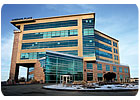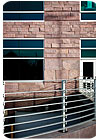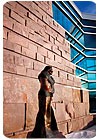
Photos © Heckel Creative
Designed as a six-story office building with underground parking, Cherapa Place in Sioux Falls, SD, is a throwback to the city’s 19th-century architectural materials as well as a testament to modern construction. The structure, which features a two-story base of regional quartzite, was created with the intention of achieving Gold LEED certification from the U.S. Green Building Council (USGBC). And the stone used throughout the exterior and interior of the project - quarried and fabricated by Jasper Stone Co. of Sioux Falls, SD, a subsidiary of L.G. Everist, Inc. - contributed to meeting the overall goals for LEED certification.
“The design goal for Cherapa Place was three-fold,” explained Jeff Hazard of Koch Hazard Architects in Sioux Falls. “We wanted to meet the basic needs of our client, which led to a 140,000-square-foot building. We also wanted the building to be ‘of Sioux Falls,’ and use local stone in an organic and innovative way. And thirdly, we wanted the building to be ‘green.’”
According to Hazard, because Cherapa Place sits on the East Bank of the Big Sioux River, adjacent to natural quartzite formations, one of the design objectives was to make the building appear as if its base is rising from the ground. Employing quartzite for the base assisted in developing this effect.
“Quartzite is a building material that once defined Sioux Falls architecture,” said the architect. “The area has a huge underlying quartzite formation. In the late 19th and early 20th centuries, it was a very popular building material. Over time, the popularity fell off, in part, because it is a relatively difficult stone to work. It took quite a bit of skill and strength to work it, and that skill was largely lost through the middle part of the 20th century. But now, it has reemerged.”
Hazard went on to explain that his firm tries to incorporate local quartzite into its Sioux Falls designs. “We use it in a different way on each building,” he said. “This was the most extensive use by far. Also, we had an owner who was pretty excited about it.”
According to the architect, the stone selection process literally took five minutes. “Basically, at the first meeting, we talked about what we wanted, and that we wanted to incorporate quartzite in the building,” said Hazard. “Because the building is located on the river and adjacent to natural quartzite formations, it was a logical choice.”
And with Jasper Stone Co.’s quartzite quarry nearby, the stone was the ideal material for a green building. “When you use local materials, obviously less energy is expended,” said Hazard.

The design
Building owner Jeff Scherschligt agreed that he was on board with the design from the initial start. “I was born in Sioux Falls and went to college in New York City,” he said. “I was a small-town kid in a big city. I was always enamored with the architecture of big buildings. I wanted to do something special that is long lasting. Nowadays, people say that they are looking for a building to last 50 years; I wanted to build a 100- to 200-year-old building.”Scherschligt explained that although the extensive use of quartzite for Cherapa Place would be a little more expensive than other building material, he was looking to tie into the historic architecture of Sioux Falls. “This is kind of an historic site in Sioux Falls,” he said. “Part of it was my desire to do something special for the community. Even though it was more expensive, I think it will save money in the long term and require less maintenance.”
In total, the exterior of Cherapa Place consists of more than 8,500 square feet of quartzite. Each piece was hand-cut and numbered before leaving Jasper Stone Co.’s facility to ensure a successful installation.
“The color [of the quartzite] varies a fair amount,” said Hazard. “We were interested in the natural variations, because we wanted the building to have a natural character. We spent a lot of time in the quarries. We hand-selected a fair amount of stone for feature pieces. One of the interesting things about quartzite is its rugged surface gives unique character. We wanted to emphasize that.”
On average, the quartzite pieces measure 36 inches tall x 60 inches wide x 10 inches thick. “The concept is that the building is kind of erupting out of the ground,” said Brian Phelps, Market Manager of Jasper Stone Co. “We started out with massive boulders, which were about 20 tons each. We bring them in like a loaf of bread and cut them into ‘slices.’ The end pieces have the natural skin of the stone, and that’s what we used on the bottom. As the building comes up more [the pieces get smoother].”
To help the quartzite pieces blend together on the building, acid etching and sandblasting techniques were used on the stone. Additionally, there was a worker on site for three months to hand-pitch the quartzite, according to Phelps. “If a saw mark was showing, it was cleaned up on site,” he said.
In total, it took Jasper Stone Co. 10 months to quarry and process the quartzite for the project. “Some of the challenges were just the size and weight of the stone,” explained Phelps. “It was very tough to handle. There were some stone pieces on the building that were roughly 3,500 pounds. We had to think, ‘How do we install them?’ and ‘How do you handle them?’ “
The same consideration also had to be applied for the interior design. The material was employed for walls and stairs - bringing texture and depth to the public spaces of the building.
Stone also defines the floor of the lobby in Cherapa Place. Quartzite, as well as a variety of slate installed by Syverson Tile & Stone of Sioux Falls, creates a colorful pattern. The majority of the tile is 12 x 12 inches.

The installation
The quartzite throughout the exterior and interior of Cherapa Place was installed by M&L Masonry of Sioux Falls. According to Rick Leitheiser, the company’s President, one of the most challenging aspects of the job was the massive size of some of the quartzite pieces. “For the bigger pieces at the bottom, we used a forklift and straps, and lifted them into place and set them down on shims underneath so we could swipe out the straps,” he said. “We then used mortar and stainless steel fasteners to secure the stone.”The installer explained that behind the stone is a precast concrete wall that was pre-made offsite. “We had to drill into that and put wedge anchors into the precast and then attached the stone pieces.”
According to Leitheiser, the hardness of the quartzite also presented a challenge. “This was a different product for us to work with,” he said. “There was a learning curve. Once the workers caught on though, it went smoother.”
Overall, the installation process took about three months, and M&L Masonry did not encounter many problems. “Jasper Stone numbered all the pieces for us, so it was done like a jigsaw puzzle,” said Leitheiser, adding that there was a total of 21 workers on the jobsite - 11 bricklayers and 10 laborers. “We estimated that there were six bricklayers [on site] a day, depending on what had to be done.”

The opening
Since its completion earlier this year, Cherapa Place has become a focal point of Sioux Falls. “It has really gotten to be an exciting thing for the community,” said Hazard. “There are people coming to the building everyday to look at it. [And] from a green angle, it has catalyzed many discussions.”The owner also shared the architect’s sentiments. “It set a standard in the community of Sioux Falls, and I think that we will be seeing more of it,” said Scherschligt. “[Also], Jasper Stone was just a joy to work with. What I really enjoyed about the company was that they were into it just as much as I was. They had an artistic tint and desire to make it right as well, and they were very creative. It was so new that they had to think about how to do things.”
